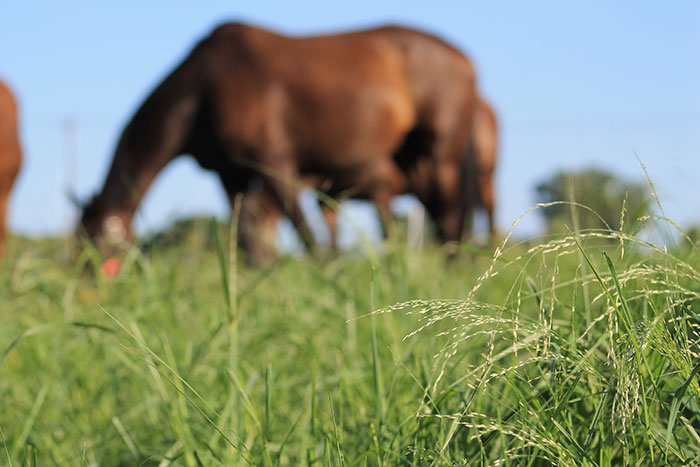
Forages play a crucial role in equine diets, but variability in nutrient content among species can lead to challenges in diet formulation to meet a horse’s nutritional needs. Protein content is one component that varies the most among forages.
“While crude protein (CP) is commonly used to estimate protein content, amino acids are a more accurate measure of protein quality,” explains a new research summary from the University of Minnesota.
Researchers evaluated the amino acid profiles and availability of legumes, warm-season grasses, and cool-season grasses (CSG).
Alfalfa, teff grass, and a mix of Kentucky bluegrass and orchardgrass were tested to represent forage legumes, warm-season grasses, and CSGs, respectively.
To evaluate the forages, six aged horses were allowed to graze pastures of each forage. Forage and blood samples were taken before turnout as well as two and four hours after turnout, and then were analyzed for amino acid concentrations.
Alfalfa and the CSG mix had a higher CP content while teff was higher in neutral detergent fiber (NDF) and acid detergent fiber (ADF), which can be seen in the table below.
While higher CP values are associated with higher amino acid concentrations, fiber content is important as it can play a role in the availability of amino acids.
The combination of low CP and high fiber content suggests that teff would have the lowest contribution to horses in terms of amino acids.
Although amino acid concentrations were highest in the CSG mix and lowest in teff, the concentration of one of the essential amino acids, lysine, was compared to the lysine requirements of different horse classes, or horses at different nutrient requirements.
For most classes, except growing horses and pregnant mares, the lysine requirement would be met grazing teff at 1.5 percent of their body weight on a dry matter (DM) basis. This indicates that the difference in amino acid content across forages may not be an issue from a physiological and performance perspective.
In the blood analysis, researchers found that the plasma amino acid concentrations did not differ regardless of forage type.
However, after four hours of grazing, a difference in threonine was observed with concentrations being highest in the horses that grazed the CSG mixture and lowest in those that grazed the teff grass. The difference in concentrations could mean that threonine might be a limiting amino acid in horses grazing teff grass.
The nutrient content of forage grazed by horses
| Nutrient | Alfalfa | CSG | Teff |
| CP, % DM | 23.3 | 24.1 | 15.4 |
| NDF, % DM | 43.2 | 53.4 | 65 |
| ADF, % DM | 33.1 | 30.9 | 37 |

Kassidy Buse was the 2018 Hay & Forage Grower summer editorial intern. She is from Bridgewater, S.D., and recently graduated from Iowa State University with a degree in animal science. Buse is currently attending the University of Nebraska-Lincoln pursuing a master’s degree in ruminant nutrition.

